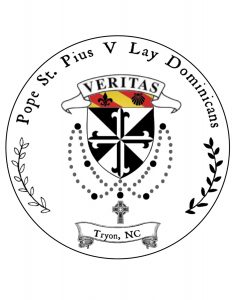
The crest for the Pope St. Pius V Lay Dominicans of Tryon, NC has many features incorporated to assist in “contemplata aliis tradere” (to hand down to others the fruits of contemplation) so it can become a means of evangelization.
The main element is the black and white Dominican Cross and Shield. The colors come from the dream of St. Dominic’s mother, where a white dog with black spots holding a torch illuminated the right path of God. The long white tunic and the contrasting black cappa of a Dominican represents truth over heresy. White reflects the purity of Christ, and the black calls us to humility and our obligation for penance. The fleur de lis on the end of each cross limb draws out the connection to France where St. Dominic first preached to the Cathars, reminding us to preach against heresies.
The red and gold field over the Dominican Cross is taken from the coat of arms of St. Pius V. Emblazoned on that field are two main elements from the crest of St. John the Baptist Parish in Tryon, NC. The fleur de lis representing the Blessed Virgin Mary, and the sea shell representing St. John the Baptist are evocative of our devotion to the Mother of God and our desire to live out our baptismal promises with Her assistance.
Surmounting all of this is “VERITAS.” To live a life in accord with reality is the Truth a Dominican seeks. The glory of a Christian is the Person of Jesus Christ who is Truth Himself (John 14:6). To claim Truth as a goal immediately places a Dominican at odds with the world, the flesh, and the devil.
Hence our weapon, the Rosary, is emblazoned as the support and foundation for our mission. Given to St. Dominic by our Lady, the Rosary is the fertilizing rain that God willed to renew the face of the earth. Champion the Rosary, save the world.
The Celtic cross on the Rosary is taken from the Diocese of Charlotte and Bishop Jugis’ coat of arms. The growing Dominican presence in our diocese is a blessing from Almighty God. Finally, the olive branches call to mind the victory of Christ in His passion, death and resurrection in which we are all called to participate (2 Cor. 4: 10-14).
